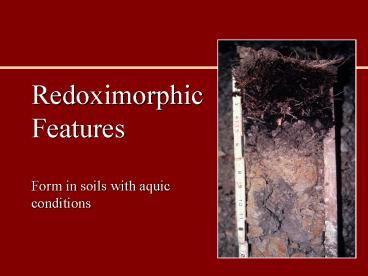Redoximorphic Features Form in soils with aquic conditions - PowerPoint PPT Presentation
1 / 33
Title:
Redoximorphic Features Form in soils with aquic conditions
Description:
... firm bodies are often relict. should be irregular in ... Fe/Mn nodule in matrix (likely relict) Hard Fe/Mn nodule in matrix ... over (relict) of past ... – PowerPoint PPT presentation
Number of Views:329
Avg rating:3.0/5.0
Title: Redoximorphic Features Form in soils with aquic conditions
1
Redoximorphic FeaturesForm in soils with aquic
conditions
2
Aquic Conditions
- Soils have an Aquic soil moisture regime if
- soils are saturated,
- soils are reduced, and
- soils have redoximorphic features
3
What is needed to form redox features?
- Anaerobic conditions (no oxygen!)
- All connected pores are filled with water that
has stood still and been depleted of dissolved O2 - Microbial activity
- gt 5 degrees C
- Food source for microbes
- Simple carbohydrates and sugars, root exudates,
dead microbe bodies - Electron acceptors present (O2, N, Mn, Fe, S,
CO2)
4
Redoximorphic Features Formation Processes
- Anaerobic conditions - absence of oxygen
- soil is saturated so almost all pores are filled
with water any dissolved O2 has been reduced to
H20 - Prolonged anaerobiosis
- changes the chemical processes in the soil
- Reduction of Fe and Mn oxides (after O and N)
- results in distinct soil morphological
characteristics - most are readily observable changes in soil color
5
Development of Hydric Soils
Inundation or soil saturation Anaerobic
conditions Chemical reduction (O, N, Fe, Mn,
etc.) Distinctive soil characteristics
6
Oxidation/Reduction Sequence
7
Soil Color and Oxidation/Reduction 1
- In subsoil horizons, Fe and Mn oxides give soils
their characteristic brown, red, and yellow
colors
8
Soil Color and Oxidation/Reduction 2
- When reduced, Fe and Mn are mobile and can be
stripped from the soil particles
Absence of Red Coatings
9
Soil Color and Oxidation/Reduction 3
- The characteristic mineral grain color is usually
a neutral gray (value gt 4, chroma lt 2)
NOTE gray doesnt mean reduced Fe is present,
but that oxidized Fe is absent
10
Redox Concentrations
Bodies of apparent accumulation of Fe/Mn oxides
- Masses
- Pore linings
- ped faces
- root channels
- Nodules and concretions
11
Masses
- soft bodies
- frequently in the soil matrix
- variable in shape
- can often be removed from the soil intact
12
Pore Linings
- coatings on a pore surface
- impregnations of the matrix adjacent to the pore
13
Pore linings
14
Nodules and Concretions
- Firm to extremely firm bodies are often relict
- should be irregular in shape
- Currently active have diffuse boundary
- halo or corona
Fe/Mn nodules washed from the soil
15
Relict Fe/Mn concretion
16
Fe/Mn concretion with reddish Fe halo
17
Redox Depletions
Bodies of low chroma where Fe/Mn oxides have been
stripped out
- generally value ? 4
- chroma ? 2
- formerly called
- gray mottles
18
Redox Depletions
19
Clay Depletions
Under severe reducing conditions, Fe and Mn are
mined from the clay mineral matrix This causes
disruption of the clay structure and
degradation followed by solubility of
byproducts Byproducts are removed from the soil
fabric, leaving a depleted area with the
neutral gray color of the natural minerals left
behind
20
Distinct or Prominent Redox Concentrations
- Page V C
- Same gt 3 or gt 2
- 1 0 and 0
- 2 - -
- Either V or C gt 3
21
Redox Concentrations
A review of their formation
(Fig. 9 from Vepraskas 1995)
22
Redox DepletionsA review of their formation
23
?, ? - Dipyridyl
- A dye used to test for the presence of reduced Fe
- pink reaction to Fe2
- dye sensitive to light and heat
- apply to freshly broken open soil clod
24
a, a - dipyridyl applied to fresh slice of soil
25
Describing Redoximorphic Features
- Concentrations and Depletions
- Describe type, color, abundance and location
- contrast can be obtained from color charts
- Reduced Matrix
- Describe reduced matrix color, oxidized color,
and time for color change to occur - a, a - Dipyridyl
- Describe of soil that reacts and location
26
Redox Concentrations
Illustration showing different kinds of redox
concentrations and their relationship to soil
macropores and matrices
27
Interpretation Problems 1
Not all aquic soils develop redoximorphic features
- Low amounts of soluble organic carbon
- High pH
- Cold temperatures
- Low amounts of Fe
- Aerated groundwater
28
Interpretation Problems 2
- Colors that look like redoximorphic features may
not be
- Weathering of primary minerals (neutral gray)
- also produce color variations (oxidized colors)
- Some rocks have gray or red colors
29
Interpretation Problems 3
Redox features may be present but do not always
indicate current hydrologic conditions
- commonly found in drained (historic) wetlands
- can be left over (relict) of past climates
30
Plinthite old redox features
31
Where is the water table?
32
Rate of Feature Formation
- Development of a 2-mm thick Fe depletion around a
root channel ranged from less than 1 to more than
100 years depending upon how long reducing
conditions occurred and how much Fe was in
solution each day - Recently constructed wetlands should have redox
depletions evident within a couple of years if
saturation occurs during the growing season
33
Interpretation Solutions
Presence of redoximorphic features must be
calibrated to specific periods of saturation
and reduction before they can be used as clear
evidence of the hydrology We need more research































